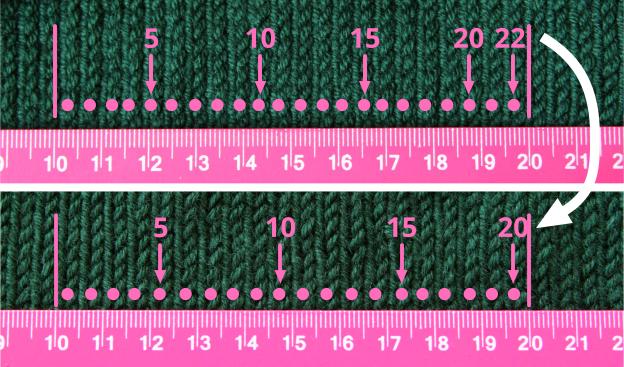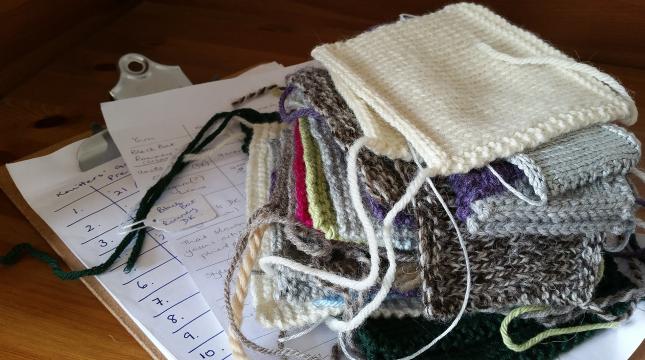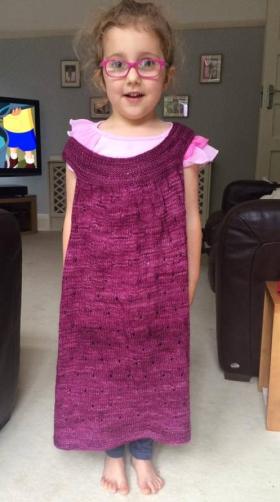
22 stitches per 10cm before blocking, 20 stitches per 10cm after wet-blocking
The Problem
Knitting often expands when it's first washed
You may have noticed that your freshly-knitted garments sometimes grow in their first wash. What's worse, any change is permanent. If you don't take this effect into account, you may end up disappointed with the final size of your project.
My own knitting can grow up to 10% larger on its first wash, so, following on from last month's gauge variation experiment where I asked twelve of my knitting friends to knit swatches with the same yarn, I decided to wet-block each of the swatches and see how it affected the gauge.
I found that two thirds of the swatches increased in size after washing, growing by up to 5%. To put that in context, a 5% enlargement is like knitting the next size up in a pattern.
It's not just wool that's affected
To see whether this problem only happens with wool, I tested other swatches made of acrylic, alpaca, cotton and silk, as well as superwash wool and untreated wool. One of the untreated wool swatches didn't change (though there were other untreated wool swatches that did) while all the rest got larger. Of those swatches, superwash wool changed the most and alpaca the least.
Changes in the swatch are mirrored in the finished garment
I wanted to check that the change in size of a swatch is matched by the changes in a finished garment. I have leftover yarn from two of my hand-knitted sweaters, so I made new gauge swatches and measured them before and after wet-blocking. Both swatches grew about 4% widthways after washing, which matched the gauge of the finished, washed sweaters.

The Solution
Wet block your swatch before measuring gauge
Wet blocking your swatch lets you find the needle size that will give you a correctly-sized garment after it has been washed, avoiding any unpleasant surprises.
Patterns rarely mention blocking, but they should!
While some independent designers do specify that gauge should be measured with a blocked swatch, most commercial patterns don't mention blocking at all.
I used to wonder if the changes that I found with blocking were somehow taken care of within the pattern sizing. However, I looked at a range of patterns and found that there is no margin built in for any change in gauge.
In all of the stocking stitch patterns that I looked at, the number of stitches was worked out directly from the finished measurements and the stated gauge. So if the gauge is 20 stitches per 10cm and the final size of the fabric needs to be 50cm wide, the pattern says to cast on 100 stitches—20 stitches exactly for each 10cm width of fabric.
This means if you work with the needle size that matches the gauge for an unblocked swatch, you'll end up with a piece of fabric that is exactly the size that you want only until the moment you first wash it. After that there's a fair chance that it will grow. Permanently.
Unfortunately wet-blocking does take extra time
There are negatives involved in washing a swatch. Putting off starting a new project to make the swatch in the first place might seem bad enough, let alone washing it and waiting for it to dry! And what if it's the wrong needle size and you have to do the same thing all over again? I'm a big fan of swatching, yet even I have limits on the amount of 'fun' I can find in knitting to get the right gauge.
There aren't many shortcuts
You can't save time by measuring a swatch that is still wet. The swatches contract a little in size as they dry. This shrinkage is fairly limited though, so you can see if a particular needle size is definitely not right while the swatch is still wet.
You can't short-cut the process by steam-blocking either, as it doesn't give the same change in gauge as washing. I measured eleven swatches in a range of fibers before blocking, after steam-blocking and then after wet-blocking. The gauge changed very little after steam blocking (mostly no change in stitch gauge, though some showed shrinkage in row gauge) but they all grew after wet-blocking (between 2% and 7%).
But I have found a couple of things that can help
Small 'test' swatches in a range of needle sizes can indicate a candidate needle size for a full-size gauge swatch. June Hemmons Hiatt suggests this in her book, The Principles of Knitting. I've tried this, making three 5x5cm swatches in three different needle sizes. They each took just minutes, and, after blocking, pointed me in the direction of the needle size to use for a larger swatch. Unfortunately it's not safe just to base the gauge of your finished item on a small swatch, as you need to measure at least 10cm, well away from the edge stitches, to find the gauge of a bigger piece of knitting.
You can speed up drying time by leaving the swatches near radiators, or in the sun.
Conclusion
In my view, wet-blocking is worth the effort
Blocking is knitting magic in its own right—you'll only really know whether a stitch pattern and fiber combination works by blocking and seeing how the fabric changes. Measuring gauge is also much easier on a blocked square compared to a curly, unblocked one.
For me, avoiding the tragedy of an expanding sweater makes it worth heading for the sink with my swatch, even though it means postponing the thrill of a new project. When I want my item to fit, it's the only safe option.

UPDATE:
A couple of weeks after I wrote this article, a friend showed me this picture of her daughter wearing a handknit tunic that that had fit her before it was washed!
Fortunately for my friend, she has an older daughter who can wear it for a while.
